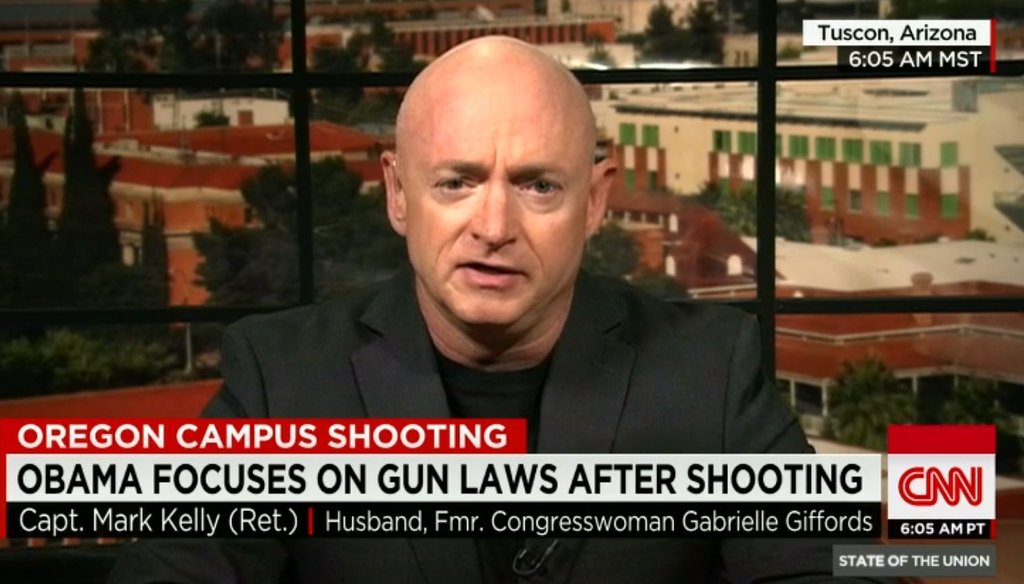Get PolitiFact in your inbox.

Capt. Mark Kelly, husband of Rep. Gabby Giffords, discusses gun policy with Jake Tapper on CNN's "State of the Union" on Oct. 4, 2015, following the school shooting in Roseburg, Oregon.
Out-of-date gun background check statistic gets new life after Oregon shooting
As the country grapples with Thursday’s mass shooting at an Oregon community college, a retired astronaut whose wife survived a killing spree four years ago is leading the charge for stricter gun control.
Mark Kelly is married to former congresswoman Gabby Giffords, who was severely injured in a 2011 mass shooting in Tucson that left 10 others dead. Following the assassination attempt, Kelly and Giffords created Americans for Responsible Solutions, a super PAC that supports gun control.
"One thing is really clear. We sell 40 percent of our guns without a background check," Kelly said during CNN’s State of the Union on Oct. 4. "That means felons, people who are dangerously mentally ill have easy access to guns."
The 40 percent figure was often invoked by gun control advocates who wanted stricter background check laws after the Newtown, Conn., elementary school mass shooting. We and other fact-checkers have pointed out that it’s based on outdated research.
We wanted to know if there had been any updates that would give this statistic more weight.
The 21-year-old statistic, recently reproduced in an unpublished survey, is still the best figure available, experts told us, thanks to a two-decade ban on federal funding of gun violence research.
Virtually all iterations of the 40 percent claim can be traced to a 1994 survey by Duke University’s Philip Cook and the University of Chicago’s Jens Ludwig. Kelly’s source is a 2013 white paper that cites Cook and Ludwig’s survey as its source, according to a spokesperson for Americans for Responsible Solutions.
The survey was based on a small sample (251 people) and counted background checks on firearm purchases before the 1996 Brady Handgun Violence Prevention Act, which required federal background checks on firearm purchases, was enacted.
There’s debate among researchers on whether the 40 percent figure still holds true today, and Cook and Ludwig have both said that no one knows the current percentage of guns sold without a background check.
Robert Spitzer, a SUNY Cortland political science professor and author of The Politics of Gun Control, noted that the background check statistic is "notoriously slippery," because gun sales that don’t go through a federally licensed seller are, as you would expect, not subject to formal record keeping.
"How would a researcher identify a sufficiently large and representative sample of non-background check gun purchases/exchanges, given the absence of a paper trail?" Spitzer said. "My general sense is that 40 percent might be on the high side but is certainly possible."
Nevertheless, it’s the best estimate we have, said Jon Vernick, co-director of the Hopkins Center for Gun Policy and Research, adding, "There's no good reason to believe that the number has changed substantially — though we can't know for sure."
Ludwig told PolitiFact that he can see why people use the 1994 survey as the benchmark, "even though everyone recognizes the estimate is now old."
So why is the most recent statistic on gun purchases without background checks about two decades old? There’s very little funding for research on gun violence.
Problems with methodology also play a role, but the 1996 appropriations bill, experts said, is mainly to blame for the lack of research dollars. Strong-armed by the powerful gun lobby, Congress wrote in a provision that effectively banned the Centers for Disease Control and Prevention from researching the roots of gun violence.
"None of the funds made available for injury prevention and control at the Centers for Disease Control and Prevention may be used to advocate or promote gun control," the bill reads.
"It basically was a shot across the bow by Congress on the part of the NRA," Mark Rosenberg, former director of the CDC’s National Center for Injury Control and Prevention, told the Washington Post. "All federally funded research was shut down."
As a result of the attack on CDC funding, all government funding for the issue was stifled, agreed David Hemenway, director of Harvard University’s Injury Control Research Center. Private foundations, too, were wary of putting dollars toward a controversial and politically divisive topic, he said. (There are fewer than five foundations providing the funding today, said Garen Wintemute, director of UC Davis’ Violence Prevention Research Program, to Slate.)
Just a few years ago, it looked like things were about to change for gun violence research. In the wake of the Newtown shooting in 2012, President Barack Obama issued a proclamation directing the CDC and other federal agencies to look into the causes of gun violence.
In spite of the presidential pressure, the 20-year moratorium on gun violence research wasn’t really lifted, and researchers haven’t exactly heeded Obama’s call. Six days after the Charleston, S.C., church shooting on June 17, 2015, House Republicans blocked an amendment that would have funded CDC gun violence research in the next fiscal year.
Instead, the appropriations bill "continues the general provision to prevent any funds provided from being spent on gun research."
Advocates of the funding ban say the research is inherently biased to support stricter gun control and is irrelevant to the mission of the CDC. In the words of outgoing House Speaker John Boehner, "a gun is not a disease."
Hemenway has managed to get around the lack of federal and private funding for gun research with a recent project financed by the Fund for a Safer Future, a program aimed at reducing gun violence. He told PolitiFact that the Harvard Injury Control Research Center conducted a 2015 national survey with a sample size over 3,000 that confirmed the 40 percent of sales without a background check figure.
However, this study has not been published, and we could not read it for ourselves, so we cannot factor it into this fact-check.
Our ruling
Kelly said, "We sell 40 percent of our guns without a background check."
The figure he’s citing comes from a 21-year-old survey with a small sample size before a key gun law took effect. Even its authors say they’re not sure if it holds true today.
Still, there are few credible alternative statistics because of a two-decade dearth of gun violence research funding.
We rate his claim Half True.
Our Sources
Email interview with Mark Prentice, spokesperson for Americans for Responsible Solutions, Oct. 4, 2015
Email interview with Philip Cook, professor of public policy at Duke University, Oct. 4, 2015
Email interview with Jens Ludwig, professor of public policy at the University of Chicago, Oct. 4, 2015
Email interview with David Hemenway, director of the Harvard Injury Control Research Center, Oct. 4, 2015
Email interview with Garen Wintemute, director of UC Davis’ Violence Prevention Research Program, Oct. 4, 2015
Email interview with Robert Spitzer, professor of political science at SUNY Cortland, Oct. 4, 2015
Garen Wintemute, "Background Checks for Firearm Transfers," February 2013
PolitiFact, "Mayor Michael Bloomberg says 40 percent of guns are sold without a background check," July 25, 2012
PolitiFact, "Kirsten Gillibrand says 40 percent of guns sold today escape background check," Jan. 13, 2013
PolitiFact, "Kaine says 40 percent of guns sales estimated to escape background checks," April 28, 2015
Washington Post Fact Checker, "The stale claim that 40 percent of gun sales lack background checks," Jan. 21, 2013
FactCheck.Org, "Guns Acquired Without Background Checks," March 21, 2013
ProPublica, "What Researchers Learned About Gun Violence Before Congress Killed Funding," Feb. 25, 2013
Washington Post, "Why the CDC still isn’t researching gun violence, despite the ban being lifted two years ago," Jan 14, 2015
The Hill, "GOP keeps in place funding ban on gun violence research," June 24, 2015
Public Radio International, "Quietly, Congress extends a ban on CDC research on gun violence," July 2, 2015
Browse the Truth-O-Meter
More by Linda Qiu
Out-of-date gun background check statistic gets new life after Oregon shooting
Support independent fact-checking.
Become a member!
In a world of wild talk and fake news, help us stand up for the facts.










































